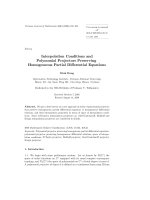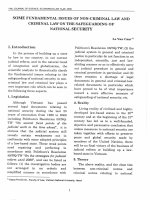DSpace at VNU: Polynomial projectors preserving homogeneous partial differential equations
Bạn đang xem bản rút gọn của tài liệu. Xem và tải ngay bản đầy đủ của tài liệu tại đây (214.05 KB, 12 trang )
Journal of Approximation Theory 135 (2005) 221 – 232
www.elsevier.com/locate/jat
Polynomial projectors preserving homogeneous
partial differential equations
Dinh-D˜unga,∗ , Jean-Paul Calvib , Nguyên Tiên Trunga
a Information Technology Institute, Vietnam National University, Hanoi, E3, 144 Xuan Thuy Rd., Cau Giay,
Hanoi, Vietnam
b Laboratoire de Mathématiques E. Picard, UFR MIG, Université Paul Sabatier, 31062 Toulouse Cedex, France
Received 20 August 2004; accepted 21 April 2005
Communicated by Borislav Bojanav
Available online 22 June 2005
Abstract
A polynomial projector of degree d on H (Cn ) is said to preserve homogeneous partial differential
equations (HPDE) of degree k if for every f ∈ H (Cn ) and every homogeneous polynomial of degree
k, q(z) = | |=k a z , there holds the implication: q(D)f = 0 ⇒ q(D) (f ) = 0. We prove that
a polynomial projector preserves HPDE of degree k, 1 k d, if and only if there are analytic
functionals k , k+1 , . . . , d ∈ H (Cn ) with i (1) = 0, i = k, . . . , d, such that is represented
in the following form
(f ) =
a (f )u +
| |
D
k | | d
| |u
with some a ’s ∈ H (Cn ), | | < k, where u (z) := z / !. Moreover, we give an example of polynomial projectors preserving HPDE of degree k (k 1) without preserving HPDE of smaller degree. We
also give a characterization of Abel–Gontcharoff projectors as the only Birkhoff polynomial projectors
that preserve all HPDE.
© 2005 Elsevier Inc. All rights reserved.
MSC: 41A05; 41A63; 46A32
Keywords: Polynomial projector preserving homogeneous partial differential equations; Space of interpolation
conditions; D-Taylor projector; Birkhoff projector; Abel–Gontcharoff projector
∗ Corresponding author.
E-mail addresses: (Dinh-D˜ung), (J.-P. Calvi),
(N.T. Trung).
0021-9045/$ - see front matter © 2005 Elsevier Inc. All rights reserved.
doi:10.1016/j.jat.2005.04.008
222
Dinh-D˜ung et al. / Journal of Approximation Theory 135 (2005) 221 – 232
1. Introduction
As usual, we denote by H (Cn ) the space of entire functions on Cn equipped with its
usual compact convergence topology, and Pd (Cn ) the space of polynomials on Cn of total
degree at most d. A polynomial projector of degree d is defined as a continuous linear map
from H (Cn ) to Pd (Cn ) for which (p) = p for every p ∈ Pd (Cn ). Such a projector
is said to preserve homogeneous partial differential equations (HPDE) of degree k if for
every f ∈ H (Cn ) and every homogeneous polynomial of degree k, q(z) = | |=k a z ,
we have
q(D)f = 0 ⇒ q(D) (f ) = 0,
(1)
| |
where q(D) := | |=k a D , D = * /*z11 . . . *znn , and | | = nj=1 j denotes the
length of the multi-index = ( 1 , . . . , n ).
In [3] Calvi and Filipsson give a precise description of the polynomial projectors preserving all HPDE. In particular they show that a polynomial projector preserves all HPDE as
soon as it preserves HPDE of degree 1. Then naturally arises the question of the existence
of polynomial projectors preserving HPDE of degree k (k 1) without preserving HPDE
of smaller degree. In this note we prove that such projectors do indeed exist and we extend
the basic structure theorem proved in [3] to this more general case. As a consequence we
show that a polynomial projector which preserves HPDE of degree k necessarily preserves
HPDE of every degree not smaller than k.
We also complete the results of [3] in another direction. Calvi and Filipsson have used their
results to give a new characterization of Kergin interpolation. Namely, they have shown that
the interpolation space of a polynomial projector of degree d (see the definition below) that
preserves HPDE contains no more than—and only Kergin interpolation projector effectively
contains—d + 1 Dirac (point-evaluation) functionals. Here we give a characterization of
Abel–Gontcharoff projectors as the only Birkhoff polynomial projectors that preserve all
HPDE (the definition are recalled in the text).
In [8] (see also [9]) Petersson has settled a convenient formalism (using the concept of
pairing of Banach spaces) and extended results of [3] to Banach spaces. Our Theorem 1 is
likely to have a similar infinite dimensional counterpart.
The main results of this paper were announced without proof in [4].
2. Definitions and background
We recall some definitions and results from [3]. A polynomial projector can be completely described by the so called space of interpolation conditions ( ) ⊂ H (Cn ), where
H (Cn ) denotes the space of the linear continuous functionals on H (Cn ) whose elements
are usually called analytic functionals. The space ( ) is defined as follows : an element
∈ H (Cn ) belongs to ( ) if and only if for any f ∈ H (Cn ) we have
(f ) = ( (f )).
Dinh-D˜ung et al. / Journal of Approximation Theory 135 (2005) 221 – 232
d} be a basis of Pd (Cn ). Then we can represent
Let {p : | |
223
as
a (f )p , f ∈ H (Cn )
(f ) =
| |
(2)
d
with some a ’s ∈ H (Cn ), and ( ) is given by
( ) = span{a : | |
d}.
In particular, in (2), we may take p = u where u (z) := z / !, z :=
n
!: =
j =1 j !. Notice that the dimension of ( ) is
n+d
n
Nd (n) :=
j
n
j =1 zj ,
,
which coincides with the dimension of Pd (Cn ). Moreover, the restriction of ( ) to Pd (Cn )
is the dual space Pd∗ (Cn ).
Conversely, if I is a subspace of H (Cn ) of dimension Nd (n) such that the restriction of
its element to Pd (Cn ) spans Pd∗ (Cn ) then there exists a unique polynomial projector ℘ (I)
such that I= (℘ (I)) . In that case we say that I is an interpolation space for Pd (Cn ) and,
for p ∈ Pd (Cn ), we have
℘ (I, f ) = p ⇔ (p) = (f ),
∀ ∈ I.
Notice that for every projector we have ℘ ( ( )) = .
Let be a polynomial projector preserving HPDE of degree 1. A function f is called
ridge function if it is of the form f (z) = h(a.z) with h ∈ H (C), where
n
yj · zj ∀y, z ∈ Cn .
y · z :=
j =1
Using (1) with polynomials q of degree 1, we can easily see that also preserves ridge
functions, that is, if f (z) = h(a.z) then there exists a univariate polynomial p such that
(h(a.·))(z) = p(a.z).
This formula defines a univariate polynomial projector which is denoted by
the following property
a (h)(a.z)
Let
that
=
a,
satisfying
(h(a.·))(z).
be d + 1 not necessarily distinct analytic functionals on H (Cn ) such
i (1) = 0 for i = 0, 1, . . . , d. Then, it was proved in [3] that
0, 1, . . . , d
I := span{D
| |
:| |
d}
(3)
is an interpolation space for Pd (Cn ), where for an analytic functional ∈ H (Cn ) and a
multi-index , the derivative D is defined as the analytic functional given by
D
(f ) := (D f ).
224
Dinh-D˜ung et al. / Journal of Approximation Theory 135 (2005) 221 – 232
The projector corresponding to space I in (3) is called D-Taylor projector. It was introduced
by Calvi [2].
For ∈ Zn+ and a ∈ Cn , the analytic functional D [a] is defined by
D [a](f ) = D f (a), f ∈ H (Cn ).
It is called discrete functional. For = 0, we use the abbreviation: D 0 [a] = [a]. Typical
D-Taylor projector is the Abel–Gontcharoff projector when i := [ai ] in (3). For other
natural examples, see [1–3,7].
be a polynomial projector of degree d in
Theorem A (Calvi and Filipsson [3]). Let
H (Cn ). Then the following four conditions are equivalent.
(1)
preserves all HPDE.
(2)
preserves ridge functions.
(3)
is a D-Taylor projector.
(4) There are analytic functionals 0 , 1 , . . . , d ∈ H (Cn ) with
such that is represented in the following form
(f ) =
D
| |
d
| | (f )u
.
i (1)=0,
i=0, 1, . . ., d,
(4)
This theorem shows that a polynomial projector
preserves all HPDE.
preserving HPDE of degree 1 also
3. Polynomial projectors preserving HPDE
In this section we extend Theorem A (and D-Taylor representation) to polynomial projectors preserving HPDE of degree k, 1 k d. We recall that the Laplace transform of an
analytic functional ∈ H (Cn ) is the entire function defined by
(w) := (ew ), w ∈ Cn ,
where ew (z) := exp(w.z). The mapping → is an isomorphism between the space of
analytic functionals and the space of entire functions of exponential type (for details, see
[5, p.108]). Notice that [a] = ea and (D )(w) = w (w).
Theorem 1. A polynomial projector of degree d preserves HPDE of degree k, 1 k d,
if and only if there are analytic functionals k , k+1 , . . . , d ∈ H (Cn ) with i (1) = 0, i =
k, . . . , d, such that is represented in the following form
(f ) =
a (f )u +
| |
D
k
| |
d
| | (f )u
(5)
n
with some a ’s ∈ H (C ), | | < k.
Proof. We first prove the sufficiency part of the theorem. Suppose that there are k , . . . , d ∈
H (Cn ) with s (1) = 0, s = k, . . . , d, such that is represented as in (5). We join any
Dinh-D˜ung et al. / Journal of Approximation Theory 135 (2005) 221 – 232
225
analytic functionals 0 , 1 , . . . , k−1 with s (1) = 0, s = 0, . . . , k − 1, to these analytic
functionals. Consider the D-Taylor projector
corresponding to the interpolation space
may be represented as
span{D | | : | | d}. Due to (4)
(f ) =
D
| |
d
| | (f )u
with 0 , 1 , . . . , d ∈ H (Cn ) and
and (5), we derive that
D
| |
=
c D
| |
| |,
d
(6)
s (1)
k
| |
Applying both sides of (7) to u , | |
D
| |
=D
| |,
k
| |
= 0, s = 0, 1, . . . , d. From the last representation
d.
(7)
d, we get
d.
Hence,
(f ) =
D
| |
| | (f )u
+
D
k
| |
d
| | (f )u
.
We now prove that preserves HPDE of degree k. Let q be a homogeneous polynomial of
degree k and f ∈ H (Cn ) such that q(D)f = 0. We prove that q(D) (f ) = 0. Indeed,
since
q(D)
D
| | (f )u
| |
= q(D)
a (f )u = 0,
| |
we have
q(D)( (f )) = q(D)(
(f )) = q(D)
D
k
Because the D-Taylor projector
q(D)( (f )) = q(D)(
| |
d
| | (f )u
.
preserves HPDE of degree k, we obtain that
(f )) = 0.
We pass to the necessary part of the theorem. Consider the following representation of
(f ) =
a (f )u .
| |
d
Take a point w ∈ Cn with w = 0. Suppose that (cs )|s|=k , cs ∈ C, is a sequence such that
cs w s = 0.
|s|=k
For the homogeneous polynomial of degree k
cs z s ,
q(z) :=
| |=k
(8)
226
Dinh-D˜ung et al. / Journal of Approximation Theory 135 (2005) 221 – 232
by (8) we have
q(D)(ew ) = 0.
Since
preserves HPDE of degree k, we obtain that
q(D)( (ew )) = 0.
From the identity
(ew ) =
a (w)u ,
d
| |
0
we derive that
cs a (w) D s u (z) = 0.
F (z) :=
|s|=k | |
(9)
d
By virtue of the equality
s,
u −s ,
0,
otherwise,
D s (u ) =
we have
F (z) =
cs
|s|=k
=
a (w)u
−s (z)
a
+s (w)u
(z)
cs a
+s (w)
| |
d,
s
| |
d−k
cs
|s|=k
=
| |
u (z).
d−k |s|=k
This means that F is a polynomial of degree d − k that is identically equal to zero due to
(9). Hence, we proved that if for (cs )|s|=k , cs ∈ C, there holds (8), then we have
cs a
+s (w)
= 0,
| |
d − k.
(10)
|s|=k
We will prove that if
a
+s (w)
w +s
and w are fixed so that w = 0 and | |
d − k, then
= const
(11)
0
= 0). There are two cases:
0
Case A: w = 0. In this case, for (cs )|s|=k , cs ∈ C, the equality
for every s with |s| = k (for convenience we put
cs w
|s|=k
+s
=0
(12)
Dinh-D˜ung et al. / Journal of Approximation Theory 135 (2005) 221 – 232
227
implies that
cs w s = 0.
(13)
|s|=k
By (10) we deduce the implication
cs w s = 0 ⇒
cs a
+s (w)
= 0.
(14)
|s|=k
|s|=k
Notice that if a, b ∈ Cm , b = 0 are given and the equality b.c = 0 implies a.c = 0 for
c ∈ Cm , then
aj
= const, j = 1, . . . , m.
bj
Therefore, from (12), (13) and (14) we prove (11).
Case B: w = 0. In this case, we will show that
+s (w)
a
= 0, |s| = k.
(15)
Fix s 0 with |s 0 | = k. Since w = 0 we can rewrite s 0 + = s 1 + 1 so that |s 1 | = k, | 1 | =
1
| | d − k, and w s = 0. Applying (10) to w and 1 gives the implication
cs w s = 0 ⇒
|s|=k
|s|=k
cs as+ 1 (w) = 0.
Hence, we have
as+ 1 (w)
ws
= const, |s| = k.
In particular, for s = s 1
as 0 + (w) = as 1 + 1 (w) = 0.
Thus, (15) has been proved. Further, we will prove that if
length i, k i d, then
a 1 (w)
w
1
=
a 2 (w)
w
2
.
1
and
2
are multi-indices with
(16)
The special case when 1 = s 1 + and 2 = s 2 + for some with | | d − k, follows
from (11). This case also implies that if is a multi-index with length i, k i d, and
= ( 1 , . . . , n ) ∈ Zn is a vector such that
n
n
| j|
j =1
k,
j
j =1
= 0,
+
∈ Zn+ ,
228
Dinh-D˜ung et al. / Journal of Approximation Theory 135 (2005) 221 – 232
then
a
+
w
(w)
+
=
a (w)
.
w
(17)
Let us now prove the general case of (16). Obviously, the case i = k follows from (11) with
= 0. Consider the case i > k. Notice that if 1 and 2 are multi-indices with length i,
then there are 1 , . . . , l ∈ Zn , (l i) such that
n
j =1
| sj |
n
s
j
k,
j =1
m
= 0,
1
+
s=1
s
∈ Zn+ ,
m = 1, . . . , l,
and
l
2
=
1
s
+
.
s=1
Applying (17) l times gives (16). By virtue of (16), we can write
a (w) = bi (w)w ,
w = 0,
| | = i,
k
i
d.
(18)
Since a is an entire function of exponential type, taking = (i) = (i ij )j =1,...,n , we
conclude that bi extends to an holomorphic function on Cns := Cn \ {w : ws = 0}, and
consequently on ns=1 Cns = Cn \{0}. Because an holomorphic function of several complex
variables has no isolated singularities (see [10, Ch.III, §11]), we may deduce that each bi
extends uniquely to an entire function which is again denoted by bi . Moreover, by (18) bi
must be an entire function of exponential type too and, therefore, the Laplace transform of
an analytic functional i , e.g., bi (w) = i (w). Thus we have
a (w) = w
i (w).
By the identity
(D
i )(w)
=w
i (w)
we obtain
a =D
i,
i = k, . . . , d.
Summing up we arrive at the conditions that there are analytic functionals k , k+1 , . . . ,
H (Cn ) such that is represented as in (5) with some a ’s ∈ H (Cn ), | | k.
d
∈
From Theorem 1 we can derive some interesting properties of polynomial projectors
preserving HPDE of degree k. First of all, observe that the equivalence of Conditions 1 and
4 in Theorem A immediately follows from Theorem 1.
Corollary 1. If the polynomial projector of degree d preserves HPDE of degree k, 1
d, then preserves also HPDE of all degree greater than k.
k
Dinh-D˜ung et al. / Journal of Approximation Theory 135 (2005) 221 – 232
229
Corollary 2. If 1 < k d, there is a polynomial projector of degree d which preserves
HPDE of degree k but not HPDE of all degree smaller than k.
Proof. Observe that as the set {u : | |
n
1 , 2 ∈ H (C ) such that
(i)
(ii)
j (1)
j (u
= 1, j = 1, 2
) = 0, 1 | | d, j = 1, 2.
1, 2
Fix two multi-indices
j
D
d} is linearly independent, there exist distinct
j (u
)=
j
,
with | 1 | = | 2 | = k − 1. We have
j = 1, 2.
of degree d defined by
Consider the polynomial projector
2
D
(f ) =
j
j (f )u
j =1
j
+
D [0](f )u .
| |
d, = 1 ,
(19)
2
is of the form (5), and by Theorem 1
preserves HPDE of degree k.
Observe that
Suppose now that also preserves HPDE of degree k − 1. Again by Theorem 1 may be
represented as follows
(f ) =
a (f )u +
| |
k−2
D
k−1
| |
d
| | (f )u
.
(20)
Comparing (19) and (20) gives
D
j
j
=D
j
k−1 ,
j = 1, 2.
Passing to the Laplace transform we have
w
j
j (w)
=w
j
k−1 (w),
j = 1, 2.
Hence, by the uniqueness principle we can easily see that
1
=
2
=
k−1
because i and k−1 are entire functions. Consequently, 1 = 2 . This contradicts our
construction of 1 and 2 . Thus it has been proved that
does not preserve HPDE of
degree k − 1. By use of Corollary 1 we deduce that does not also preserve HPDE of any
degree smaller than k.
be a polynomial projector of degree d preserving HPDE of degree
Corollary 3. Let
k, 1 k d. Then there are functionals k , k+1 , . . . , d with i (1) = 1 (k i d) such
that the set
span{D
s
: | | = s, s = k, . . . , d}
230
Dinh-D˜ung et al. / Journal of Approximation Theory 135 (2005) 221 – 232
is a proper subset of ( ). Moreover, if is represented as in (5) with i (1) = 1, i =
k, . . . , d, and if, for some with | | k, we have D ∈ ( ) then there exists a relation
j
d−| |
=
| |
+
cl1 l2 ...lj
j =1 l1 l2 ...lj
*
| |+j
*zl1 . . . *zlj
,
(21)
where each lk is taken over {1, 2, . . . , n}.
Proof. We just need to prove (21). It follows from (5) that the map
f →
a (f )u
| |
k−1
is a polynomial projector of degree k −1. In particular, the restrictions of the a ’s are linearly
independent on Pk−1 (Cn ). Now, for some coefficients c we have
D
c a +
=
| |
k−1
c D
k
| |
If follows that for every with | |
0=
d
| |.
(22)
k − 1, we have
c a (u ).
| |
k−1
Since the restrictions of the a ’s are linearly independent on Pk−1 (Cn ) we deduce that
c = 0 for | | k − 1. Hence we have
D
=
c D
k
| |
d
| |.
Now taking the Laplace transforms of both sides and expanding them in power series, we find
by identifying the coefficients that every coefficient c must vanish if does not belong to
Z( ) which is the set of all multi-indices such that | | d, j
= .
j , j = 1, . . . , n,
Taking out the common factor w on both sides and returning to the functionals, we obtain
the claimed representation.
4. A characterization of Abel–Gontcharoff projectors
A Birkhoff projector is called a polynomial projector
for which ( ) is generated
by discrete functionals that is to say by functionals of the form D [a]. For results on
Birkhoff interpolation we refer to [6]. The following theorem might seem intuitively clear
but we found no immediate proof. It is worth noting that this result is typical for the higher
dimension. It is indeed not true in dimension 1 in which the concept of projector preserving
all HPDE reduces to a triviality.
Dinh-D˜ung et al. / Journal of Approximation Theory 135 (2005) 221 – 232
231
Theorem 2. Let be a Birkhoff projector of degree d on Cn , n 2. Then preserves all
HPDE if and only if it is an Abel–Gontcharoff projector, that is, there are a0 , . . . , ad ∈ Cn
not necessary distinct such that
( ) = span{ D [as ] : | | = s, s = 0, . . . , d }.
Proof. The sufficiency part is trivial. We prove that the condition is necessary. For k =
0, 1, . . . , d, we set
Ak ( ) := {a ∈ Cn : ∃ , | | = k, D [a] ∈ ( )}
and sk = cardAk ( ). When sk = 0 we define
Ak ( ) = {ak1 , ak2 , . . . , aksk },
j
j
where ak = ak for j = j . It has been shown in [3, Proposition 2] that if is a polynomial
projector preserving all HPDE and if D [a] ∈ ( ) for one multi-index of length k, then
D [a] ∈ ( ) for every multi-index of the same length k. This implies that
j
{D [ak ] : k ∈ J, | | = k, j = 1, . . . , sk } ⊂ ( ),
where J is the set of all k such that Ak ( ) is not empty. The set on the left-hand side above
will be denoted by ( ). Since this set is linearly independent and since is a Birkhoff
projector it forms a basis of ( ). Thus, what we need to prove is only that sk = 1 for
k = 0, 1, . . . , d. For b ∈ Cn , b = 0, we define the linear mapping b · from H (Cn ) into
H (C) as follows
(b
)(h) := (h(b.·)).
It was proved in [3, Proposition 1] that the restriction of this mapping to ( ) is a linear
mapping from ( ) onto ( b ) (see Section 2 for the notation), that is,
b
( )= (
b ).
Step 1: We prove that dk=0 sk = d + 1. As n > 1, we can choose a (nonzero) b ∈ Cn
j
so that for k ∈ J the elements b.ak , j = 1, . . . , sk , are pairwise distinct. From the equality
j
j
b D [ak ] = b D k [b.ak ]
for any multi-index of length k, and the existence of a multi-index of length k such that
b = 0, we deduce that the discrete functionals
j
D k [b.ak ],
k ∈ J, j = 1, . . . , sk ,
(23)
j
b.ak
span ( b ). Moreover, because the sk complex numbers
are pairwise distinct, the
discrete functionals in (23) are linearly independent and, therefore, form a basis of ( b ).
Consequently, we have
dim( (
b ))
=
sk
(24)
k∈J
and the claim is proved since dim( (
b ))
= d + 1 and
k∈J sk
=
d
k=0
sk .
232
Dinh-D˜ung et al. / Journal of Approximation Theory 135 (2005) 221 – 232
Step 2: We prove that sk 1 for k = 0, . . . , d. Suppose to the contrary that there is k0
such that sk0 2. We can choose a nonzero b∗ ∈ Cn so that b∗ .ak10 = b∗ .ak20 . Then the set
j
{D k0 [b∗ .ak0 ], j = 1, . . . , sk0 }
contains at most sk0 − 1 functionals. Consequently, the cardinality of the set
j
{D k [b∗ .ak ], k ∈ J, j = 1, . . . , sk }
(25)
is at most ( k∈J sk )−1 which is, in view of Step 1, not greater than d. This is a contradiction,
because the functionals in (25) span ( b∗ ) which has dimension d + 1.
The two steps imply that sk = 1 for k = 0, . . . , d, and this concludes the proof.
Acknowledgments
The authors would like to thank Carl de Boor for his valuable remarks which improved
presentation of the paper.
References
[1] M. Andersson, M. Passare, Complex Kergin interpolation, J. Approx. Theory 64 (1991) 214–225.
[2] J.P. Calvi, Polynomial interpolation with prescribed analytic functionals, J. Approx. Theory 75 (1993)
136–156.
[3] J.P. Calvi, L. Filipsson, The polynomial projectors that preserve homogeneous differential relations: a new
characterization of Kergin interpolation, East J. Approx. 10 (2004) 441–454.
[4] Dinh-D˜ung, J.P. Calvi, N.T. Trung, On polynomial projectors that preserve homogeneous partial differential
equations, Vietnam J. Math. 32 (2004) 109–112.
[5] L. Hörmander, An introduction to Complex Analysis in Several Variables, third ed., North-Holland,
Amsterdam, 1990.
[6] R.A. Lorentz, Multivariate Birkhoff interpolation, Lecture Notes in Mathematics, No. 1516, Springer, Berlin,
1992.
[7] C.A. Micchelli, A constructive approach to Kergin interpolation in Rk : multivariate B-splines and Lagrange
interpolation, Rocky Mountain J. Math. 10 (1980) 485–497.
[8] H. Petersson, Kergin interpolation in Banach spaces, Stud. Math. 153 (2) (2002) 101–114.
[9] H. Petersson, The PDE-preserving operators on nuclearly entire functions of bounded type, Acta Math.
Hungar. 100 (1–2) (2003) 69–81.
[10] B.V. Shabat, Introduction to Complex Analysis, Part II. Functions of Several Complex Variables, American
Mathematical Society, Providence, RI, 1992.









